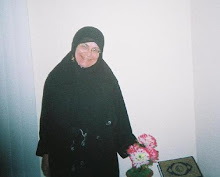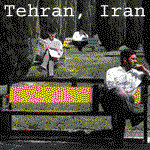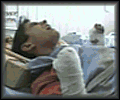America's WMD
Two years before the invasion of Iraq, a report [Radiological toxicity of DU] commissioned by the World Health Organization warned that the long-term health of Iraq's civilian population would be damaged by the use of depleted uranium (DU) - radioactive waste from the nuclear industry which is used to harden missiles, shells and bullets and which slices through tank armor like a knife through butter. The WHO did not make the report public. Odd, that.
DU has been called the "Trojan Horse" of the wars in Iraq - and Afghanistan and Kosovo and Bosnia - a weapon that keeps on killing. On detonation, DU armaments release a spray of radioactive dust that can be carried in the air over long distances and which, when inhaled, goes into the body and stays there. The dust remains radioactive for 4.5 billion years.
The WHO report was written by three of Europe's top radiation scientists, including Dr. Keith Baverstock, for more than a decade the WHO's leading expert on radiation and health. After retiring from the WHO, Baverstock leaked the report to the media earlier this year. It concluded that microscopic particles of DU would be blown around and inhaled by Iraqi civilians for years to come, and could trigger the growth of malignant tumors. Baverstock believes the WHO deliberately suppressed the report - probably under pressure from the International Atomic Energy Agency (IAEA), a more powerful UN body that promotes nuclear power. In response, WHO claims the IAEA's role was "very minor" and says the report was not approved for publication because "parts of it did not reflect accurately what a WHO-convened group of international experts considered the best science in the area of depleted uranium."
In other words, its own chosen experts got it wrong. Odd, again.
Had the study had been published in November 2001, Baverstock believes there would have been more pressure on the Allies to limit their use of DU during the invasion of Iraq - and to clean up afterward. But it wasn't published. As a result, Iraq is now playing host to some 350 tons of DU fired in 1991, but also to more than 1,000 tons reportedly fired in 2003.
[Mindfully.org note: the official figure is actually 2,200 tons! Knowing how the military likes to minimize such news, the tonnage could be double that. ] The "reportedly" is needed here because the armed forces are playing coy with figures. No wonder: handlers of DU in the US and Britain are required to wear masks and protective clothing. Imagine Iraqis having to dress like that for 4.5 billion years.
Nuha al-Radi, the much-loved Iraqi artist and diarist who died in Beirut on August 31, believed her leukemia could have been caused by DU. And if not DU, then something else to which Iraqis were knowingly exposed in the wars since Saddam Hussein invaded Kuwait. For DU is not the only concern in the "toxic wasteland" that many scientists say Iraq has become. There are also the chemical weapons the Baath regime used against its own people, and in its war with Iran, and, most recently, the chemical and biological materials released into the atmosphere by Allied bombing of Iraqi stockpiles in the first Gulf war of 1991.
Nuha, who didn't believe the first war would take place, was devastated by the second. "The carnage takes place in apocalyptic proportions," she wrote at her lowest point. "Sometimes I want to cry, but I resist. I am totally withered, and feel so useless." We talked of working together on a film that would investigate the pollution of Iraq and its people. Nuha was convinced that DU was entering the water table and flowing into every corner of the country, poisoning everything. But she fell ill, and we did nothing.
Looking at the DU debate now, one thing is crystal-clear: there are two very district bodies of opinion - and both claim to be informed. The question is, by what?
On one side, there are the governments that use DU weapons, the IAEA, NATO and WHO, who maintain (publicly, at least) that DU is not particularly dangerous and has no long-term effects. On the other side, united by varying degrees of concern, are the European Parliament, which has called for an immediate moratorium on the use of DU weapons, Belgium, Portugal, France, Spain and Italy, who don't use them and want an inquiry into them; the United Nations Environmental Program; and many independent scientists, several of whom have first-hand experience of the legacy of DU.
After the first Gulf war, Dr. Asaf Durakovic, a colonel in the US Army Medical Corps, was put in charge of Nuclear Medicine Service at the Department of Veterans Affairs Medical Center. He discovered unusual radiation levels in veterans and became convinced not only that DU was killing them, but also that it was causing changes in the human gene pool that would damage future generations. He found "considerable resistance" from the government to his work on DU and was asked to stop. He refused. Two months after writing to President Bill Clinton to request an inquiry into DU contamination, he was fired - and went on to become Clinical Professor of Radiology and Nuclear Medicine at Georgetown University in Washington.
A nutter? Hardly. Yet Durakovic says soil samples from Iraq show radiation levels 17 times higher than is acceptable - threatening, he says, environmental "catastrophe." He believes that DU contamination from the 1991 war may have exposed the entire Gulf population.
When the 1991 war started, Dr. Doug Rokke, a Vietnam veteran, forensic scientist and retired army major, was recalled from academia and sent to the Gulf as part of the army's Depleted Uranium Assessment team. "The US Army made me their expert," he says. "I went into the project with the total intent to ensure they could use uranium munitions in war, because I'm a warrior. What I saw as director of the project led me to one conclusion: uranium munitions must be banned from the planet, for eternity, and medical care must be provided for everyone" - those on the firing end and those on the receiving end.
Many in Rokke's Gulf team are now dead. He himself suffers from serious health problems including brain lesions and lung and kidney damage. When government doctors finally agreed to test him in November 1994, three-and-a-half years after he fell ill, while he was director of the Pentagon's Depleted Uranium Project, he was found to have 5,000 times the permissible level of radiation in his body - enough to light up a small village.
DU, he says, is the stuff of nightmares.
Julie Flint is a veteran journalist based in Beirut and London. This is the first of two articles on depleted uranium, which she wrote for THE DAILY STAR
source: http://www.dailystar.com.lb/article.asp?edition_id=10&categ_id=5&article_id=8333 13sep04
 Picture of Agent Orange or Dioxin kills and is one of America's WMD Weapon of Mass Destruction during Vietnam.
Picture of Agent Orange or Dioxin kills and is one of America's WMD Weapon of Mass Destruction during Vietnam. Further Reading:


















0 Comments:
Post a Comment
<< Home